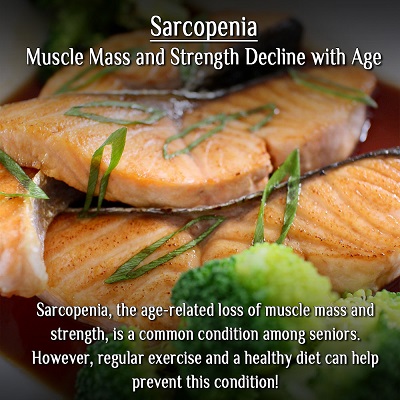 Are you worried about declining muscle mass? Do you feel as though you have no muscle strength anymore? As you age you may gradually lose some of your muscle mass, which is normal, and can be largely prevented, but perhaps you have heard of the term ‘sarcopenia’ and wonder what it is all about.
Are you worried about declining muscle mass? Do you feel as though you have no muscle strength anymore? As you age you may gradually lose some of your muscle mass, which is normal, and can be largely prevented, but perhaps you have heard of the term ‘sarcopenia’ and wonder what it is all about.
What is Sarcopenia?
Sarcopenia is a progressive loss of skeletal muscle mass, along with strength and function due to aging. Your body is not producing enough proteins needed to build muscles, so the muscles become smaller. Hormonal changes also happen as you age, which can affect muscle fibers and lead to sarcopenia.
A poor diet and inactivity are huge contributors to this disease. It affects 1 in 10 adults aged 50 years and above and can shorten life expectancy. The rate of muscle loss increases as you age, especially if not detected and addressed.
Common factors that can lead to sarcopenia include obesity, chronic diseases, malnutrition, reduced hormone levels, insulin resistance, and rheumatoid arthritis.
One of the common symptoms of sarcopenia is muscle weakness. Eventually, you could lose your mobility and independence. As the disease progresses as you age, you might need long-term care. Your musculoskeletal system can become frail, making you more prone to falls and injuries.
How is Sarcopenia Treated?
While sarcopenia can occur naturally, certain practices can help prevent or reverse it, mostly involving lifestyle changes.
Here are a few ways to help prevent and address the problems of sarcopenia:
Regular Exercise and Physical Activities
If you suffer from sarcopenia, one way to manage it and prevent progression is to be more physically active. It is beneficial to engage in progressive resistance-based strength training, which can strengthen your muscles and reverse muscle loss.
Resistance training includes using resistance bands, leg presses, or weightlifting. Resistance exercise creates tension in your muscle fibers, sending growth signals to increase muscle strength and repair muscle cells.
Exercising for fitness is also effective in helping to control sarcopenia. Exercises include aerobic exercise, endurance training, and flexibility training combined with resistance training. Jogging, cycling, hiking, and walking can help reverse sarcopenia.
Healthy Diet
Changing to healthier eating habits and a nutritious diet can also reverse the effects of sarcopenia. You need to increase your dietary protein intake and ensure that you are not deficient in vitamins and minerals, such as vitamin D and creatine. These are important for muscle growth itself and for optimizing the body’s growth response to exercise.
Meat, fish, eggs, poultry, and dairy foods are good sources of protein. Legumes, tree nuts, soy, and yogurt are also protein-packed.
Supplements
As shown above, protein and vitamins and minerals can help with this condition, so if your diet is lacking, supplements may prove to be beneficial.
Here are a few and how they help:
- Vitamin D can help improve muscle function.
- Creatine supplements help improve muscle strength. (Creatine is a natural substance that is actually found in our muscle cells.)
- Protein supplements and whey protein are often used to help improve muscle mass.
Other options include testosterone supplements and growth hormone supplements which can help with muscle growth and development.
Signs of Sarcopenia
Sarcopenia has several symptoms, such as a decrease in muscle mass (size) and strength which you may notice in your arms and legs, decreased mobility and fitness, fatigue, and loss of stamina. As a result, you may have increased difficulty doing daily tasks, or walking, or climbing stairs.
Do not simply self-diagnose yourself. Sarcopenia should be diagnosed by your healthcare provider through a physical exam. They will also use a few tests that measure muscle strength and mass. These include a handgrip test, a walking speed test, and others.
Final Thoughts
People naturally lose muscles as they grow older, but they can slow down and even reverse muscle mass loss if they exercise and eat healthy! If you want to prevent or have already been diagnosed with sarcopenia, it is time to make some positive lifestyle changes. You can prevent further loss and reverse the effects of sarcopenia.
‘Many consequences of sarcopenia are preventable or even reversible. Progressive resistance exercises can produce substantial increases in strength and muscle size, even in the oldest old.’ – Source
It is important to increase your protein intake and exercise regularly using a combination of resistance, fitness, flexibility, and endurance training. These exercises will help your muscles grow and become stronger. If you have chronic health conditions, always consult your doctor for better guidance on what will work for you the best!






